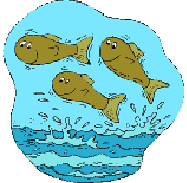BACKGROUND:
Students have learned about animals
that live on land. Some animals like frogs, start their life in the
water, and then emerge to live on land near water. Animals have many
different habitats in which they live.
A frog is an amphibian that is at home both on land
and in fresh water. The process that transforms a frog from water to
land is called "metamorphosis." As a tadpole, they
have a very dangerous life. Many predators like fish, turtles, birds,
and even large insects look for the young tadpoles to eat. Different
frog species have different growth rates. Some become frogs within
weeks, however some like the North American bullfrog may take more than a
year to fully develop. The rate of metamorphism is also influenced by
temperature of water and other chemical factors.
 Organisms that live in the marine
environment must be able to adapt their bodies to the salt water. They also
need to have a supply of nourishment similar to organisms that live on land.
The ocean usually has nourishment throughout the water as dissolved minerals.
Food created by algae is floating within the upper 200 meters of the water
column. Water allows organisms to move around with greater ease than on land. Organisms that reside in the ocean live in certain
areas of the ocean just like land animals live in certain areas. Whales for instance have a much larger habitat than an elephant, because the
whales can move within the ocean of their birth.
Organisms that live in the marine
environment must be able to adapt their bodies to the salt water. They also
need to have a supply of nourishment similar to organisms that live on land.
The ocean usually has nourishment throughout the water as dissolved minerals.
Food created by algae is floating within the upper 200 meters of the water
column. Water allows organisms to move around with greater ease than on land. Organisms that reside in the ocean live in certain
areas of the ocean just like land animals live in certain areas. Whales for instance have a much larger habitat than an elephant, because the
whales can move within the ocean of their birth.
The beach is an area that is half water and
half land. Many portions of the beach are covered by water part of the time,
so it is not a friendly area to live.
Shallow waters are usually close to the
coast. Organisms, like crabs, clams, corals, and seastars reside in this area.
Fish can also live in shallow, and deep water. Deep water organisms include
porpoises, fishes, and deep water clams.
PROCEDURE:
- Emphasize with students that there are
many habitats in which organisms live in both water and land. Read
"Frog Tales," to students and then discuss the habitat in
which frogs live. You may also go into the metamorphosis from
tadpole to frog by using the plastic model.
The "Early Tadpole" is newly emerged from its jelly egg.
The tadpole is fishlike in appearance and has not legs nor can
croak. An "Intermediate Tadpole" shows small
stumps on both sides of its body. These stumps will later develop
into the hind legs. A "Tadpole with legs," has all
4 legs. Gills are replaced by lungs, mouth and eyes become bigger,
and the intestine shrinks. A "Pre-frog"
continues to develop as the tail continuously shrinks. Its
metamorphosis will be complete when the last part of its tail
disappears.
- Provide students with copy of the worksheet.
This picture shows the different habits of the ocean including deep
marine water, shallow marine, and beach environment. Notice that deep water is
closest to the bottom of the paper and shallow is toward the beach and land.
The view is that of a sail or on a ship in deep water looking towards land.
- Distinguish for students the differences
between deep and shallow waters. Have students draw a line to where they think
each organism on the worksheet lives or cut out the pictures and have students
paste them on. You many want to include other pictures you may have, or
stickers of fish or other marine creatures. You may want students to color the
different portions of the ocean and land. Make sure you discuss the organisms
first and then have the students complete the lab sheet. You may also
want to just have students use a blank piece of paper and cut and paste
objects from magazines or pictures that you may have.
- Answers: Land: tree; Shallow water:
snail, crabs, conch, crab, seaweed, and some fish; deep water: fish, ray (some
snails and conchs can live in deeper water)